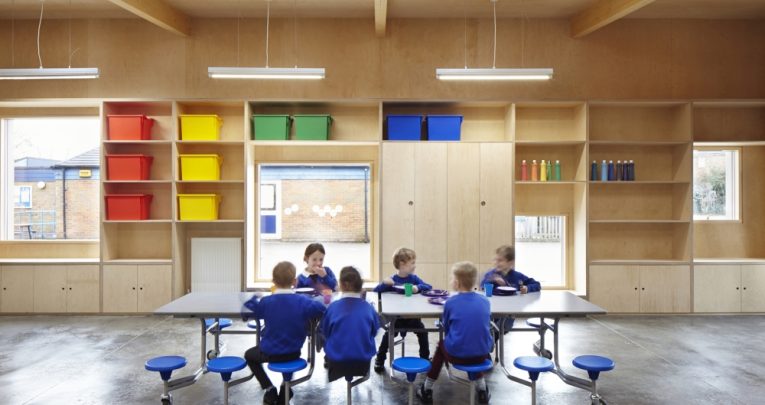8 Reasons Why RIBA Is Calling For A Rethink On How Schools Are Built And Maintained

New report from the Royal Institute of British Architects criticises poor communication, lack of flexibility and 'over-engineering' in government's school building programme

- by Teachwire

Today sees the publication of a report by the Royal Institute of British Architects (RIBA), which calls for an urgent review of the Education Funding Agency’s school building programme.
RIBA’s ‘Better Spaces for Learning’ report brings together a comprehensive analysis of primary and secondary buildings across the UK, a nationwide poll of teachers and consultation with school buildings experts. You can read the full report via the download link above – here are our eight takeaways…
1. The EFA school building programme is too rigid
The report calls on the government to consider how schools can become more engaged with building programmes and have meaningful input into design briefs.
RIBA suggests that one way of doing this would be for the DfE to provide teachers with briefing guidance – something that RIBA says it would be happy to assist with.
2. Contractors are often given incomplete and inaccurate briefs for new school buildings
The report single out the government’s current policy of aiming to deliver school designs within six weeks. While conceding that there can be a place for ‘quicker, more focused procedures’, RIBA argues that this ultimately creates ‘Significant time pressures for all involved’, and recommends that the EFA review the timeframes and budgets set aside for schools site assessment.
The report goes on to cite frequent complaints from architects, engineer and contractors working on schools projects regarding the standard of initial information they’re supplied with by the EFA – and describes site assessments carried out by the agencys technical advisors as ‘Often simply not thorough enough.’
3. The standards and design criteria set by the EFA need to be made clearer
According to RIBA’s findings, contractors remain unsure as to whether the EFA’s baseline standards and designs are a set criteria to which buildings must be built, or whether they’re intended to serve as more flexible standard that contractors are expected to meet and potentially exceed by innovating. As the report puts it, ‘Are they a floor or a ceiling?’
The report highlights an apparent lack of clarity even among EFA advisors as to what the standards mean. RIBA found a lack of flexibility when designating areas for building, for example, which it puts down to, ‘Many EFA Technical and Design Advisors treating the EFA area requirements as both a minimum and a maximum, discouraging contractors from going beyond them.’
The report cites one particular instance in which ‘Outdoor space on top of a double-height atrium was not allowed even though it could have been delivered within cost limitations, due to the Design Advisor’s rigid advice on maximum area being that of the EFA’s minimum area requirement.’
4. There’s more to a well-designed school than decent classrooms
The report also points out that the current focus on classroom designs risks neglecting those other areas of a school that have an impact on learning – particularly what RIBA sees as the ‘narrower corridors’ specified within the current EFA basline standards.
These, it says, can, ‘Increase stress levels [and] exacerbate bullying problems….narrow crowded corridors also mean higher maintenance costs through faster wear and tear as pupils are pushed against surfaces,’ concluding that given rising pressure on school places, ‘this is an area that we believe needs urgent reconsideration.’
5. Teachers are changing jobs because of how bad their school’s buildings are
According to figures from a ComRes poll of teachers commissioned by RIBA, 1 in 5 teachers had considered quitting due to the condition of the school buildings in which they taught.
6. New schools are increasingly ‘over-engineered’
The report also notes that new school buildings tend to be fitted with with expensive, government-mandated management equipment – heating and ventilation systems, for example – which are often difficult for staff to operate without professional assistance and frequently entail higher running costs.
The figures aren’t insignificant – according to RIBA’s research, better school design before now could have potentially saved the English school estate more than £150 million of unnecessary maintenance costs annually.
7. Well-designed schools produce measurable results
Based on the results of 129 post-occupancy evaluations (POEs) carried out by academics and industry professionals at primary, secondary and SEND schools across the UK, the report calculates that good school buildings have positive effects on behaviour (particularly the layout of toilets and the design of circulation spaces are concerned) and engagement, through the addition of different types of spaces and consistent colour schemes.
Those schools that scored highest on the POEs were also found to demonstrate a 15% increase on staff productivity..
8. There’s too much central planning
Finally, there’s criticism for what RIBA describes as the government’s ‘one-size-fits-all’ approach to the construction of new schools. The report concedes that the EFA has ‘Succeeded in delivering schools to incredibly tight budgets’ – but that this has been accompanied by major restrictions in terms of school design and how quickly they need to be completed.
Instead, RIBA recommends that the government focuses on addressing three key areas:
• That the flow of information between schools, the EFA and those bidding for contracts be improved
• That a more flexible approach to the design of school buildings be put in place, to allow for the unique challenges faced by each school
• That there be a change of focus in how schools buildings are expected to provide a good learning environment – one which prioritises appropriate design solutions, over the mandatory installation of complex and costly mechanical/electrical equipment that may not be suitable for a school’s particular needs.
For more information, visit www.architecture.com or follow @RIBA











